Performance Characterization of Waterborne Epoxy Resin and Styrene–Butadiene Rubber Latex Composite Modified Asphalt Emulsion (WESAE)
Abstract
:1. Introduction
2. Materials
2.1. SBR Modified Asphalt Emulsion (SBRAE)
2.2. Waterborne Epoxy Resin (WER) and Curing Agent
2.3. Waterborne-Epoxy–SBR Composite Modified Asphalt Emulsion (WESAE)
3. Experiment Methods
3.1. Storage Stability Test
3.2. Fluorescence Microscope Test
3.3. Standard Viscosity Test
3.4. Residue Tests
3.4.1. Penetration and Softening Point Tests
3.4.2. Differential Scanning Calorimetry (DSC) Test
3.4.3. Dynamic Shear Rheological (DSR) Test
3.4.4. Adhesion test
3.5. Fourier-Transform Infrared Spectroscopy (FT-IR) Test
4. Results and Discussion
4.1. Storage and Workability Characterization of WESAE
4.1.1. Storage Stability
4.1.2. Particle Distribution Uniformity
4.1.3. Workability
4.1.4. Analysis of Variance Test
4.2. Performance Characterization of WESAE Evaporation Residue
4.2.1. High-Temperature Performance
4.2.2. Temperature Sensitivity
4.2.3. Rheological Properties
4.2.4. Adhesion with the Coarse Aggregate
4.2.5. Analysis of Variance Test
4.3. Comprehensive Performance Evaluation and Cost Analysis for WESAE
4.3.1. Comprehensive Performance Evaluation of WESAE
4.3.2. Cost Analysis of WESAE
4.4. Modification Mechanism Analysis of WER
5. Summary and Conclusions
- The content of WER has a significant effect on the storage stability of WESAE. A small amount of WER can slightly improve the storage stability compared to the SBRAE, but an excessive dosage will result in an obvious decrease in the storage stability of the WESAE. When the WER content reaches 4%, the one-day storage stability of the WESAE exceeds the specification limit.
- When the WER content reaches 4%, the microsphere particles of the WESAE agglomerate after the WESAE is stored for 24 h. Furthermore, the average particle diameter and the particle diameter distribution width of the WESAE with 4% WER reach 19.456 and 22 μm at 24 h of storage, respectively, which are far greater values than for SBRAE at the same storage time.
- The workability of the WESAE is affected by the WER content and storage time. At any storage time, the viscosity of the WESAE gradually increases with the increase of WER content; the sensitivity of the WESAE viscosity to time is gradually enhanced by increasing the WER content. The addition of 3% WER content can be regarded as the maximum amount to guarantee viscosity, and the prepared WESAE with 3% WER should be used within 24 h.
- The content of WER has a remarkable impact on the WESAE residue properties in terms of temperature performance, thermal stability, rheological properties, and adhesion with the aggregate. It is evident that 3% WER improves these properties in the SBRAE residue.
- The WESAE with 3% WER shows the most comprehensive performance. Thus, the optimal WER content considering storage stability, workability, residue properties, and cost is determined to be 3% of the WESAE by weight.
- The modification of SBRAE by WER is a physical method; no chemical reaction occurs in the blending process.
Author Contributions
Funding
Conflicts of Interest
References
- He, Y.H.; Zhang, R.H. Application of emulsified asphalt modified water-epoxy resin to maintenance of highway. New Build. Mater. 2007, 05, 37–40. (In Chinese) [Google Scholar]
- Chen, Z.D.; Zhang, Z.; Wu, Y.J.; Niu, X.H.; Chen, Z.F. Application of waterborne epoxy emulsified asphalt. Road Mach. Constr. Mech. 2017, 34, 23–28. (In Chinese) [Google Scholar]
- Malladi, H.; Castorena, C. Field measurements of emulsion application rates and pavement emulsion absorption in tack coats and chip seals. Constr. Build. Mater. 2019, 218, 701–711. [Google Scholar] [CrossRef]
- Galaviz-Gonzalez, J.R.; Cueva, D.A.; Covarrubias, P.L.; Palacios, M.Z. Bonding evaluation of asphalt emulsions used as tack coats through shear testing. Appl. Sci. Basel 2019, 9, 1727. [Google Scholar] [CrossRef] [Green Version]
- Abedini, M.; Hassani, A.; Kaymanesh, M.R.; Yousefi, A.A. The rheological properties of a bitumen emulsion modified with two types of SBR latex. Petrol. Sci. Technol. 2016, 34, 1589–1594. [Google Scholar] [CrossRef]
- Chen, X.H.; Liu, S.; Sun, L.F. Preparation and properties of emulsion asphalt modified by nano silica/SBR composite. China Rubber Ind. 2007, 54, 337–340. (In Chinese) [Google Scholar]
- Abd El-Rahman, A.M.M.; El-Shafie, M.; Abo-Shanab, Z.L.; El-Kholy, S.A. Modifying asphalt emulsion with different types of polymers for surface treatment applications. Petrol. Sci. Technol. 2017, 35, 1473–1480. [Google Scholar] [CrossRef]
- Ji, J.; Liu, L.H.; Suo, Z.; Xu, Y.; Yang, S.; Xu, S.F. Performance of micro-surfacing with waterborne epoxy resin modified emulsified asphalt. J. Chang’an Univ. (Nat. Sci. Ed.) 2017, 37, 23–30. (In Chinese) [Google Scholar]
- Hou, S.G.; Chen, C.; Zhang, J.H.; Shen, H.J.; Gu, F. Thermal and mechanical evaluations of asphalt emulsions and mixtures for microsurfacing. Constr. Build. Mater. 2018, 191, 1221–1229. [Google Scholar] [CrossRef]
- Qian, H.T.; Gao, S.Q. Application study on waterborne epoxy emulsified asphalt for pavement seal coat. Petrol. Asph. 2015, 29, 40–43. (In Chinese) [Google Scholar]
- Zhang, Q.; Hao, P.W.; Bai, Z.Y. Properties of asphalt emulsion modified with waterborne epoxy resin and SBR composite. New Build. Mater. 2015, 42, 43–46. (In Chinese) [Google Scholar]
- Li, X.J.; Bi, W.L.; Shi, F.Z.; Lv, J.W.; Hui, Z.F. Research on the compound modification effect of waterborne epoxy resin on SBR emulsified asphalt. J. Chongqing Jiaotong Univ. (Nat. Sci.) 2018, 37, 40–46. (In Chinese) [Google Scholar]
- Zhang, Q.; Xu, Y.H.; Wen, Z.G. Influence of waterborne epoxy resin content on performance of waterborne epoxy resin compound SBR modified emulsified asphalt for tack coat. Constr. Build. Mater. 2017, 153, 774–782. [Google Scholar] [CrossRef]
- Chang, R.T.; Du, S.J.; Pei, Q.; Guo, Y.Y.; Pang, J.Y. Effect of SBR on the rheological properties of emulsified asphalt. J. Chongqing Jiaotong Univ. (Nat. Sci.) 2016, 35, 38–41. (In Chinese) [Google Scholar]
- Zhou, W.F.; Dong, L.W.; Song, X.Y.; Yang, Z.W. Study on high-temperature performance of waterborne epoxy modified emulsified asphalt. J. Chongqing Jiaotong Univ. (Nat. Sci.) 2019, 38, 55–59. (In Chinese) [Google Scholar]
- Li, X.J.; Hui, Z.F.; Yan, H.Z.; Zhang, H. Experimental analysis of the adhesive performance of waterborne epoxy modified emulsified asphalt. J. Build. Mater. 2019, 22, 160–166. (In Chinese) [Google Scholar]
- Li, R.; Leng, Z.; Zhang, Y.; Ma, X. Preparation and characterization of waterborne epoxy modified bitumen emulsion as a potential high-performance cold binder. J. Clean. Prod. 2019, 235, 1265–1275. [Google Scholar] [CrossRef]
- Thermal Analysis and Thermo-Physical Instruments Home Page. Available online: http://www.ngb-netzsch.com.cn/products/dsc.html (accessed on 24 March 2020).
- ASTM Standard 2018. Standard Test Method for Enthalpies of Fusion and Crystallization by Differential Scanning Calorimetry, E793-06; ASTM International: West Conshohocken, PA, USA, 2018. [Google Scholar]
- Anton Paar Home Page. Available online: https://www.anton-paar.com/corp-en/ (accessed on 24 March 2020).
- AASHTO Standard 2019. Standard Method of Test for Multiple Stress Creep Recovery (MSCR) Test of Asphalt Binder Using a Dynamic Shear Rheometer (DSR), T350-19; American Association of State Highway and Transportation Officials (AASHTO): Washington, DC, USA, 2019. [Google Scholar]
- Hassanpour-Kasanagh, S.; Ahmedzade, P.; Fainleib, A.M.; Behnood, A. Rheological Properties of asphalt binders modified with recycled materials: A comparison with Styrene-Butadiene-Styrene (SBS). Constr. Build. Mater. 2020, 230, 117047. [Google Scholar] [CrossRef]
- Gu, Y.; He, L.H.; Yang, F. Research review on the compatibility of waterborne epoxy emulsified asphalt. Petrol. Asph. 2018, 32, 1–9. (In Chinese) [Google Scholar]
- Meng, Y.; Dong, C.J. Analysis on effect factors of emulsified asphalt storage stability. Petrol. Asph. 2015, 29, 31–34. (In Chinese) [Google Scholar]
- Zhang, Q.; Hao, P.W.; Bai, Z.Y. Research on preparation and adhesion of emulsified asphalt modified with waterborne epoxy resin. J. Highw. Transp. Res. Dev. 2015, 32, 9–14. (In Chinese) [Google Scholar]
- Chinese Industry Standard 2004. Technical Specification for Construction of Highway Asphalt Pavements, JTG F40-2004; Ministry of Transport of the People’s Republic of China (MOT): Beijing, China, 2004.
- Abdullah, G.M.S.; Wahhab, H.I.A.A. Stabilisation of soils with emulsified sulphur asphalt for road applications. Road Mater. Pavement Des. 2019, 20, 1228–1242. [Google Scholar] [CrossRef]
- Querol, N.; Barreneche, C.; Cabeza, L.F. Asphalt emulsion formulation: State of the art of formulation, properties and results of HIPR emulsions. Constr. Build. Mater. 2019, 212, 19–26. [Google Scholar] [CrossRef]
- Zheng, M.L.; Fan, X.P.; Li, H.Y.; Lin, X.Y.; Liu, P. Research progress of waterborne epoxy emulsified asphalt for road. China Sci. Paper 2019, 14, 821–829. (In Chinese) [Google Scholar]
- Cao, W.D.; Liu, S.T.; Li, X.X. Laboratory evaluation of the effect of composite modifier on the performance of asphalt concrete mixture. Constr. Build. Mater. 2017, 155, 363–370. [Google Scholar] [CrossRef]
- Xue, W. Statistical Analysis and SPSS Application, 5th ed.; China Renmin University Press: Beijing, China, 2017; ISBN 978-73-0024-609-3. [Google Scholar]
- Ding, H.B.; Qiu, Y.J.; Rahman, A. Low-temperature reversible aging properties of selected asphalt binder based on thermal analysis. J. Mater. Civil Eng. 2019, 31, 04018402. [Google Scholar] [CrossRef]
- Xu, L.; Xiong, W.H. Analysis for dependency between eigenvalues of DSC endothermic peak of asphalt and temperature susceptibility indices. Technol. Highw. Transp. 2014, 34–36. (In Chinese) [Google Scholar]
- Behnood, A. Application of rejuvenators to improve the rheological and mechanical properties of asphalt binders and mixtures: A review. J. Clean. Prod. 2019, 231, 171–182. [Google Scholar] [CrossRef]
- Lv, Q.; Huang, W.D.; Sadek, H.; Xiao, F.P.; Yan, C.Q. Investigation of the rutting performance of various modified asphalt mixtures using the Hamburg Wheel-Tracking Device test and Multiple Stress Creep Recovery test. Constr. Build. Mater. 2019, 206, 62–70. [Google Scholar] [CrossRef]
- Tang, N.P.; Huang, W.D. High temperature performance evaluation and grading of SBS modified asphalt based on multiple stress creep recovery test. J. Build. Mater. 2016, 19, 665–671. (In Chinese) [Google Scholar]
- Hu, C.C.; Zhao, J.Y.; Leng, Z.; Partl, M.N.; Li, R. Laboratory evaluation of waterborne epoxy bitumen emulsion for pavement preventative maintenance application. Constr. Build. Mater. 2019, 197, 220–227. [Google Scholar] [CrossRef]
- Chen, Q.; Wang, C.H.; Fu, H.; Zhang, L. Durability evaluation of road cooling coating. Constr. Build. Mater. 2018, 190, 13–23. [Google Scholar] [CrossRef]
- Zhang, W.J.; Yuan, H.P. A weighted multi-objective gray target decision model for selecting an optimum ESCO. Chin. J. Manag. Sci. 2019, 27, 179–186. (In Chinese) [Google Scholar]
- Shen, A.Q.; Chen, X.; Guo, Y.C.; Li, P. Road performance evaluate on effects of steel slag asphalt mixture based on grey target decision. Bull. Chin. Ceram. Soc. 2019, 38, 1245–1252. (In Chinese) [Google Scholar]
- Chen, J.J. Comparison of SBS latex replacement SBR latex used in modified emulsified asphalt. Petrol. Asph. 2017, 31, 18–21. (In Chinese) [Google Scholar]
- Gu, Y.; Tang, B.M.; He, L.H.; Yang, F.; Wang, H.; Ling, J.M. Compatibility of cured phase-inversion waterborne epoxy resin emulsified asphalt. Constr. Build. Mater. 2019, 229, 116942. [Google Scholar] [CrossRef]
- Zhou, Q.W.; Ling, T.Q.; Hao, Z.H.; Wu, X.L.; Li, L.; Xu, G.H. Feature analysis of waterborne epoxy resin-emulsified asphalt blend. J. Build. Mater. 2018, 21, 414–419. (In Chinese) [Google Scholar]


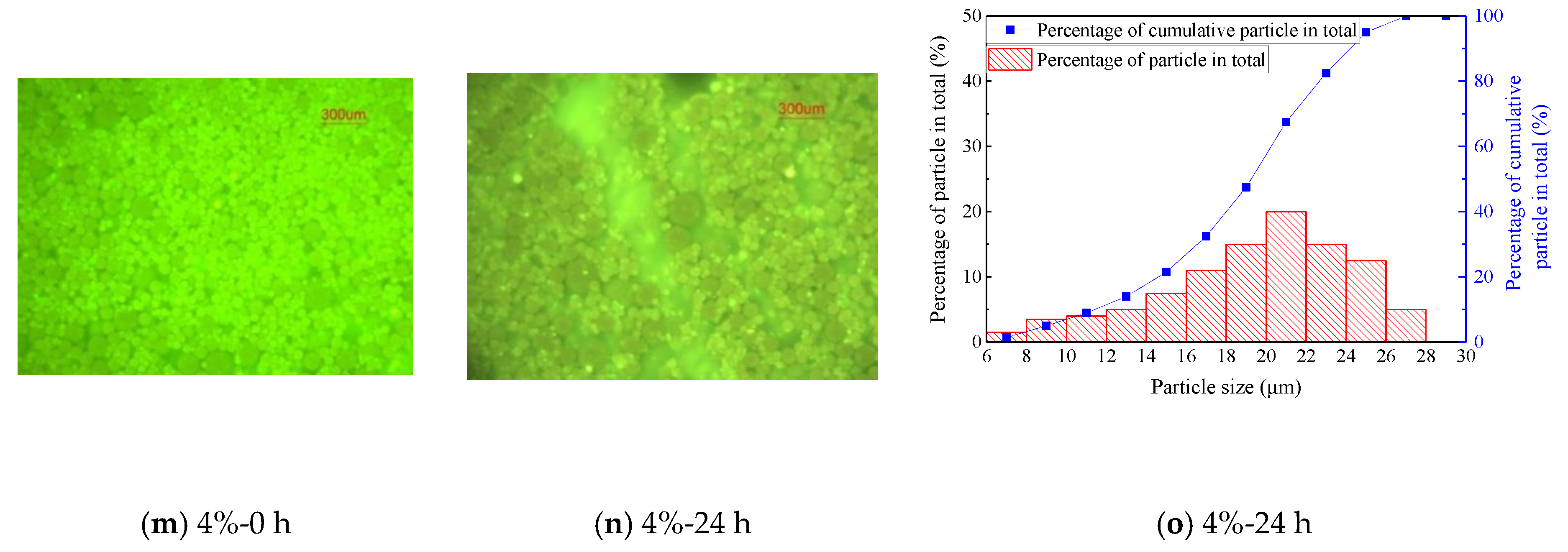
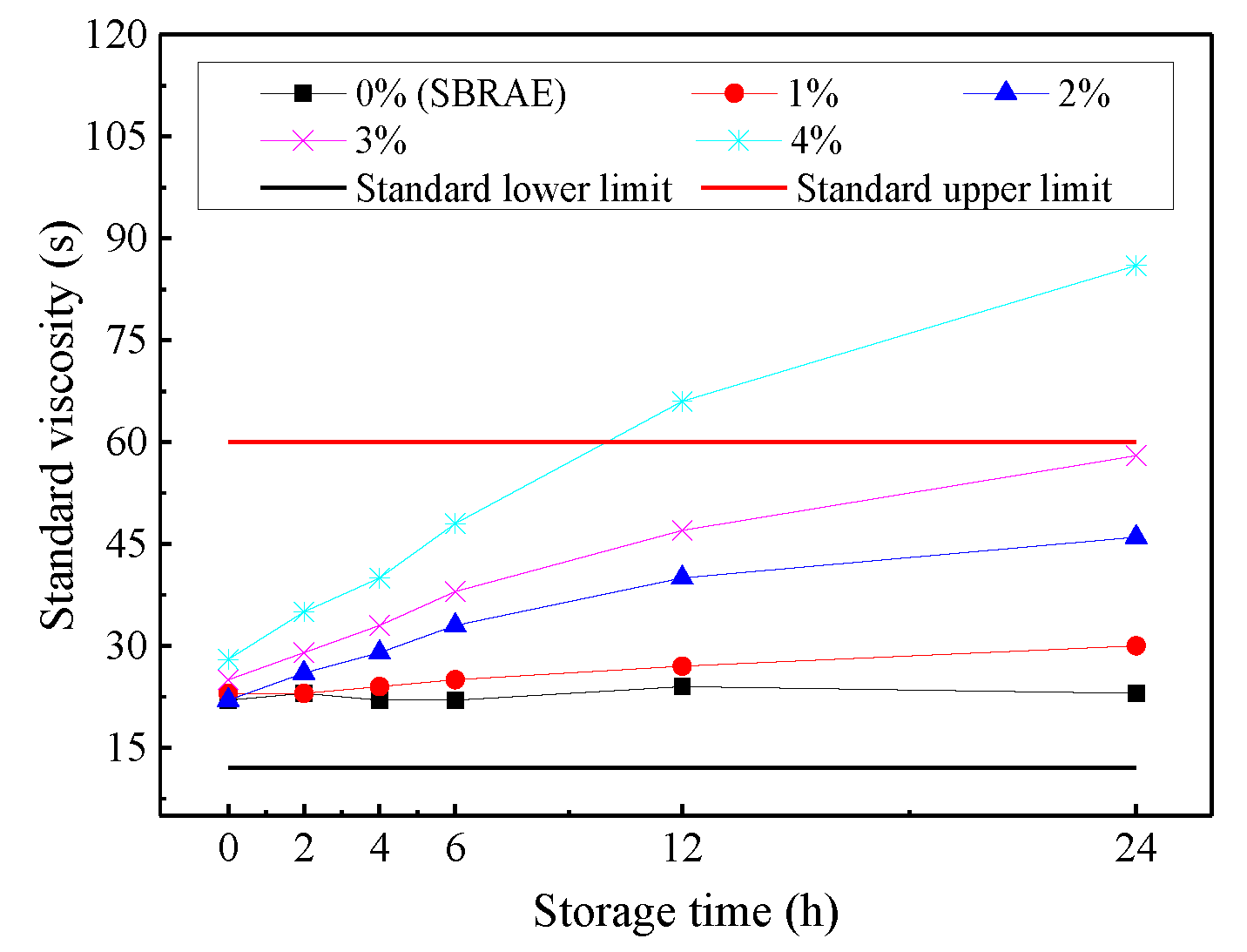


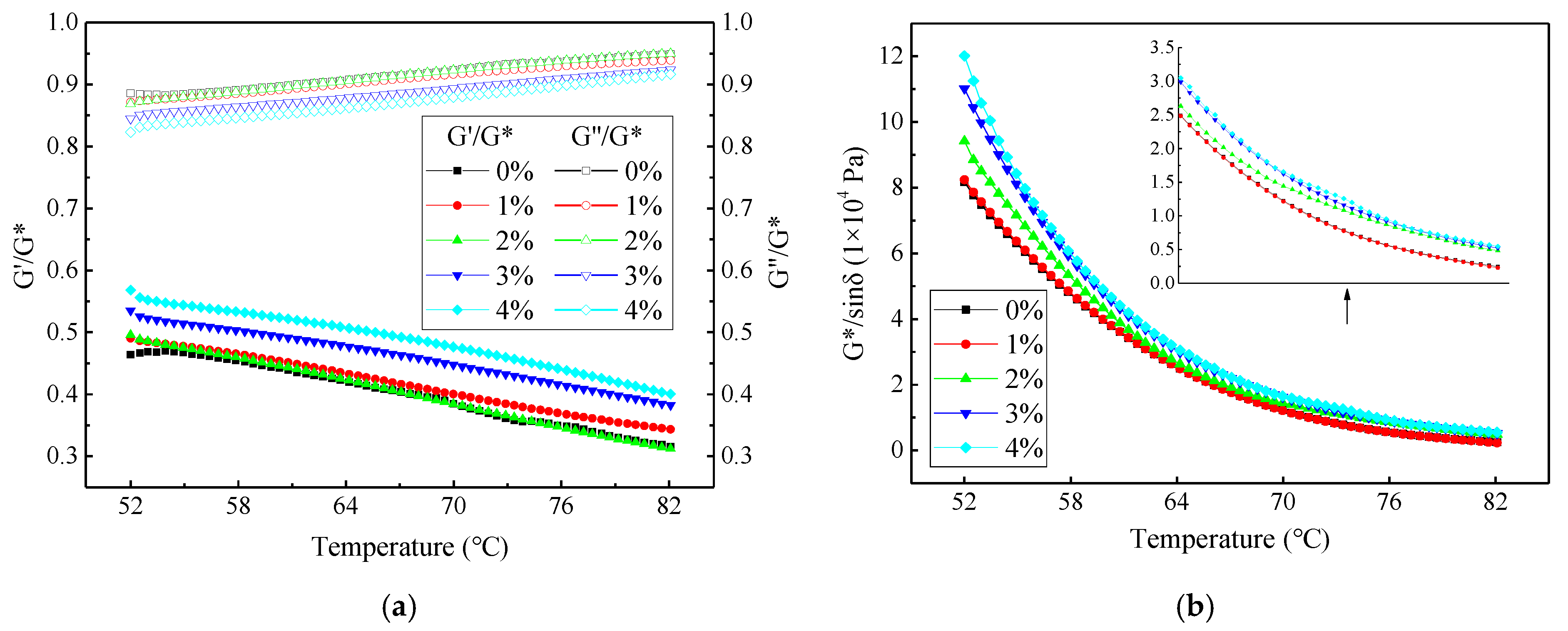
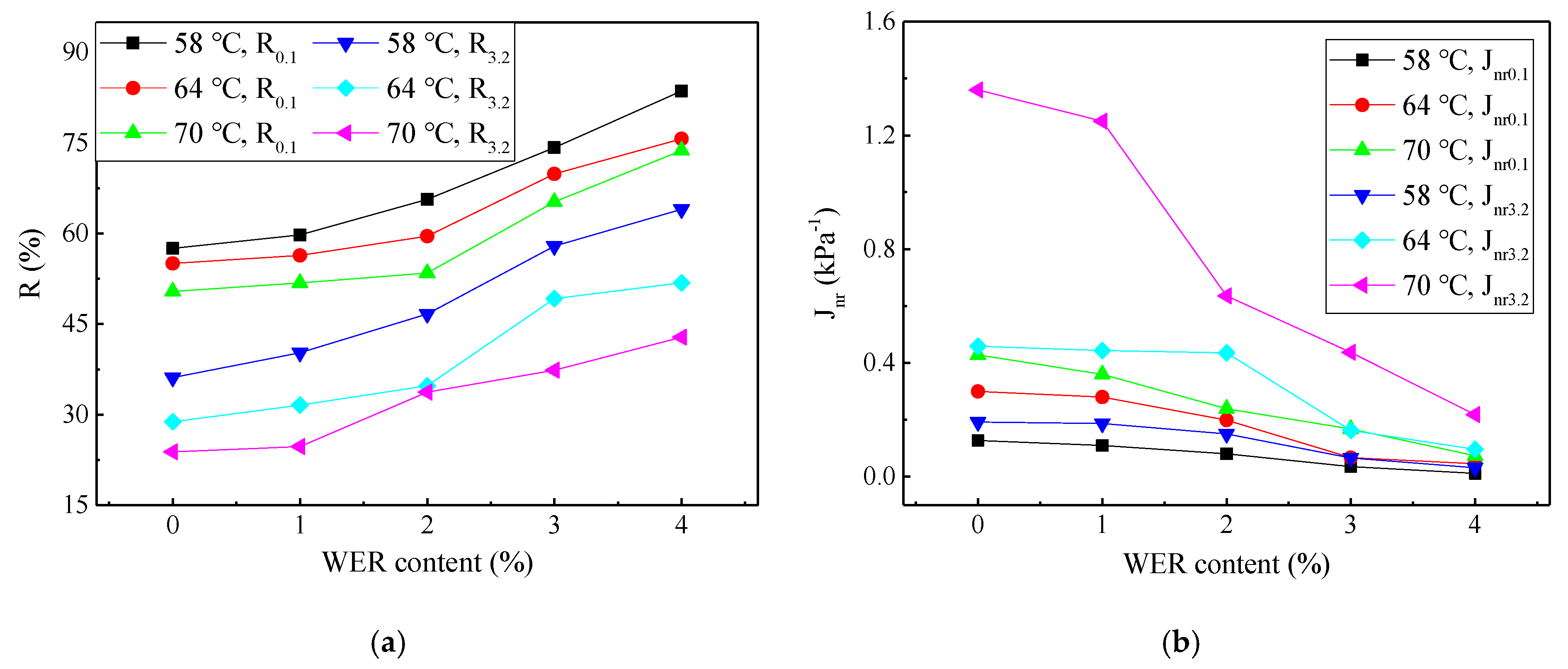
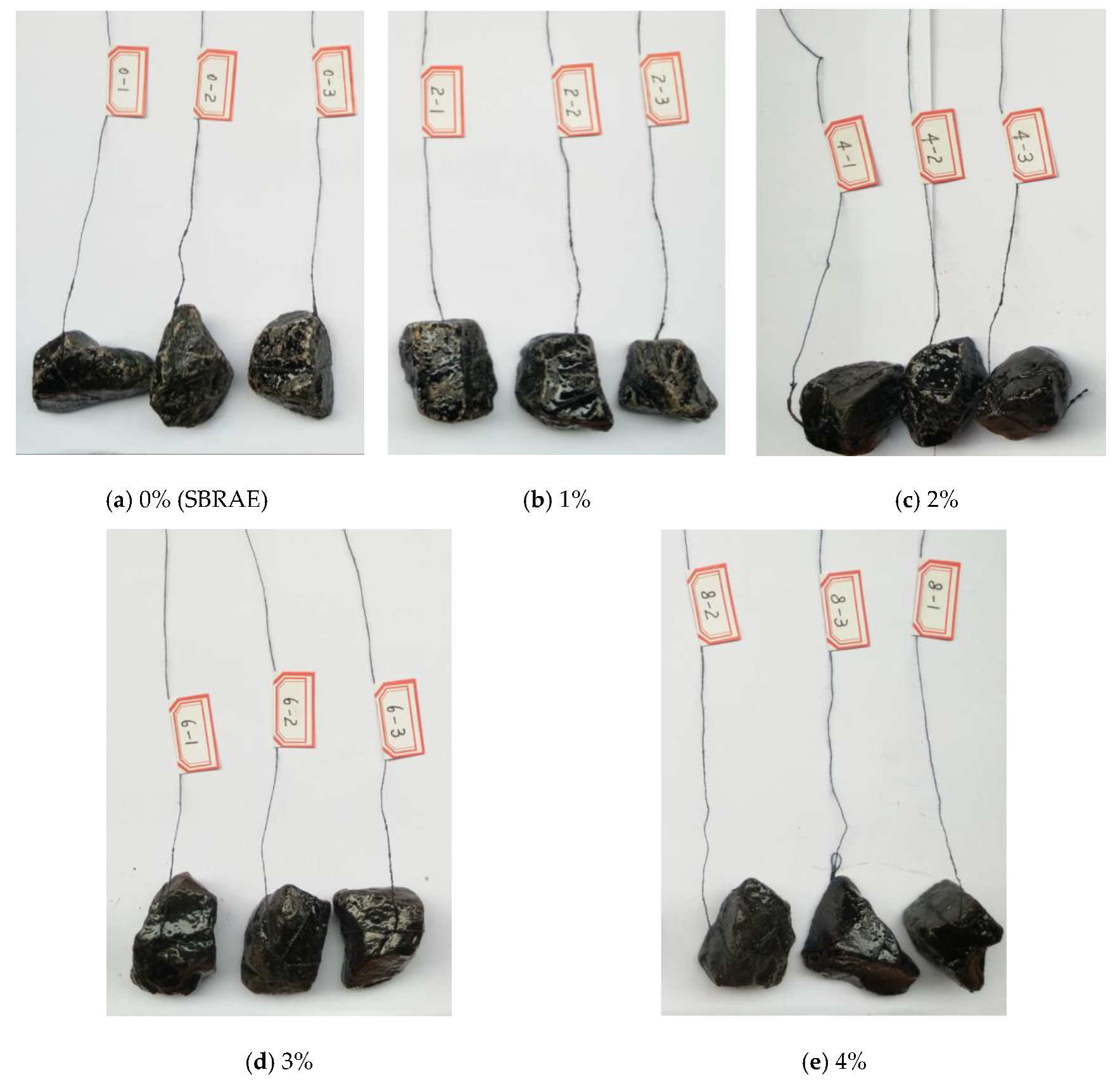

| Contents | Measured Values | Technical Requirements | Test Methods | |
|---|---|---|---|---|
| Remaining amount on 1.18 mm sieve (%) | 0.01 | ≤0.1 | T 0652 | |
| Standard viscosity (s) | 22 | 12–60 | T 0621 | |
| 1 d storage stability (%) | 0.7 | ≤1 | T 0655 | |
| 5 d storage stability (%) | 4.2 | ≤5 | T 0655 | |
| Evaporation residue | Content (%) | 61.7 | ≥60 | T 0651 |
| Penetration at 25 °C (0.1 mm) | 66 | 40–100 | T 0604 | |
| Softening point (°C) | 55.0 | ≥53 | T 0606 | |
| Ductility at 5 °C (cm) | >100 | ≥20 | T 0605 | |
| Items | Types | Appearances | Resin Content (%) | Epoxy Equivalent (g/mol) | Amine Value (mg KOH/g) | pH Value |
|---|---|---|---|---|---|---|
| WER | Modified by chemical method | Milk white | 60 ± 2 | 180–230 | – | 3.5 ± 1 |
| Curing agent | Epoxy-amine adduct | Light yellow | 45 ± 2 | – | 220–280 | 9.5 ± 0.5 |
| Properties | Dependent Variables | F-Statistics | Significance (p-Value) | |
|---|---|---|---|---|
| Storage stability | Residue content difference | 162.712 | 0.000 | |
| Workability | Standard viscosity | 0 h | 29.042 | 0.000 |
| 2 h | 99.292 | 0.000 | ||
| 4 h | 236.600 | 0.000 | ||
| 6 h | 300.781 | 0.000 | ||
| 12 h | 669.289 | 0.000 | ||
| 24 h | 1941.857 | 0.000 | ||
| Samples | Endothermic Peak 1 | Endothermic Peak 2 | Enthalpy per Unit Mass (J/g) | ||||
|---|---|---|---|---|---|---|---|
| Temperature (°C) | Peak Range (°C) | Enthalpy (J/g) | Temperature (°C) | Peak Range (°C) | Enthalpy (J/g) | ||
| 0% (SBRAE) | 99.431 | 77.659–102.712 | 0.197 | 110.598 | 104.154–131.104 | 0.168 | 0.365 |
| 1% | 99.170 | 74.752–108.211 | 0.265 | 144.541 | 140.282–147.087 | 0.024 | 0.289 |
| 2% | 99.225 | 77.985–103.095 | 0.185 | 140.466 | 134.228–147.307 | 0.083 | 0.268 |
| 3% | 99.556 | 92.070–102.465 | 0.068 | 139.669 | 136.046–147.205 | 0.083 | 0.151 |
| 4% | 99.160 | 91.839–101.334 | 0.069 | 142.664 | 135.788–147.001 | 0.037 | 0.106 |
| WER Content (%) | Number | Mass (g) | Spalling Rate α (%) | Average Spalling Rate (%) | ||
|---|---|---|---|---|---|---|
| m1 | m2 | m3 | ||||
| 0 (SBRAE) | 0–1 | 23.72 | 23.86 | 23.82 | 28.57 | 31.16 |
| 0–2 | 22.79 | 23.03 | 22.95 | 33.33 | ||
| 0–3 | 20.50 | 20.69 | 20.63 | 31.58 | ||
| 1 | 2–1 | 17.80 | 18.01 | 17.96 | 23.81 | 26.36 |
| 2–2 | 20.61 | 20.94 | 20.85 | 27.27 | ||
| 2–3 | 16.77 | 17.02 | 16.95 | 28.00 | ||
| 2 | 4–1 | 20.15 | 20.40 | 20.35 | 20.00 | 19.96 |
| 4–2 | 16.58 | 16.82 | 16.77 | 20.83 | ||
| 4–3 | 21.01 | 21.22 | 21.18 | 19.05 | ||
| 3 | 6–1 | 25.74 | 25.99 | 25.96 | 12.00 | 11.87 |
| 6–2 | 21.63 | 21.79 | 21.77 | 12.50 | ||
| 6–3 | 21.36 | 21.45 | 21.44 | 11.11 | ||
| 4 | 8–1 | 19.08 | 19.20 | 19.19 | 8.33 | 9.60 |
| 8–2 | 20.96 | 21.10 | 21.09 | 7.14 | ||
| 8–3 | 18.70 | 18.85 | 18.83 | 13.33 | ||
| Properties | Dependent Variables | F-Statistics | Significance (p-Value) | ||
|---|---|---|---|---|---|
| High temperature | Penetration | 1347.083 | 0.000 | ||
| Softening point | 461.650 | 0.000 | |||
| Temperature sensitivity | Enthalpy per unit mass | 24.623 | 0.004 | ||
| Rheology | Temperature scanning test | G*/sinδ | 58 °C | 42.714 | 0.000 |
| 64 °C | 22.155 | 0.002 | |||
| 70 °C | 15.352 | 0.004 | |||
| MSCR test | R0.1 | 58 °C | 175.876 | 0.000 | |
| 64 °C | 185.395 | 0.000 | |||
| 70 °C | 101.112 | 0.000 | |||
| R3.2 | 58 °C | 172.054 | 0.000 | ||
| 64 °C | 264.951 | 0.000 | |||
| 70 °C | 138.875 | 0.000 | |||
| Jnr0.1 | 58 °C | 243.837 | 0.000 | ||
| 64 °C | 98.191 | 0.000 | |||
| 70 °C | 422.054 | 0.000 | |||
| Jnr3.2 | 58 °C | 202.847 | 0.000 | ||
| 64 °C | 145.917 | 0.000 | |||
| 70 °C | 63.910 | 0.000 | |||
| Adhesion | Spalling rate | 55.556 | 0.000 | ||
| Schemes | WER Content (%) | Performance Indices | ||||||
|---|---|---|---|---|---|---|---|---|
| Objectives k | ||||||||
| k = 1 | k = 2 | k = 3 | k = 4 | k = 5 | k = 6 | k = 7 | ||
| Residue Content Difference (%) | Viscosity at 12 H of Storage (s) | Softening Point (°C) | Enthalpy per Unit Mass (J·g−1) | Jnr0.1 at 64 °C (kPa−1) | Spalling Rate (%) | WESAE Cost (yuan/kg) | ||
| 1 | 0 | 0.7 | 24 | 52.5 | 0.365 | 0.2994 | 31.16 | 3.676 |
| 2 | 1 | 0.4 | 27 | 53 | 0.289 | 0.2801 | 26.36 | 4.083 |
| 3 | 2 | 0.6 | 40 | 56 | 0.268 | 0.1987 | 19.96 | 4.436 |
| 4 | 3 | 0.8 | 47 | 61.5 | 0.151 | 0.0669 | 11.87 | 4.789 |
| 5 | 4 | 1.6 | 66 | 63.5 | 0.106 | 0.0456 | 9.60 | 5.141 |
© 2020 by the authors. Licensee MDPI, Basel, Switzerland. This article is an open access article distributed under the terms and conditions of the Creative Commons Attribution (CC BY) license (http://creativecommons.org/licenses/by/4.0/).
Share and Cite
Yang, J.; Zhang, Z.; Fang, Y.; Luo, Y. Performance Characterization of Waterborne Epoxy Resin and Styrene–Butadiene Rubber Latex Composite Modified Asphalt Emulsion (WESAE). Coatings 2020, 10, 352. https://doi.org/10.3390/coatings10040352
Yang J, Zhang Z, Fang Y, Luo Y. Performance Characterization of Waterborne Epoxy Resin and Styrene–Butadiene Rubber Latex Composite Modified Asphalt Emulsion (WESAE). Coatings. 2020; 10(4):352. https://doi.org/10.3390/coatings10040352
Chicago/Turabian StyleYang, Jianhua, Zhengqi Zhang, Ying Fang, and Yaofei Luo. 2020. "Performance Characterization of Waterborne Epoxy Resin and Styrene–Butadiene Rubber Latex Composite Modified Asphalt Emulsion (WESAE)" Coatings 10, no. 4: 352. https://doi.org/10.3390/coatings10040352




